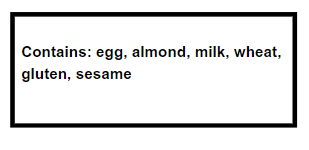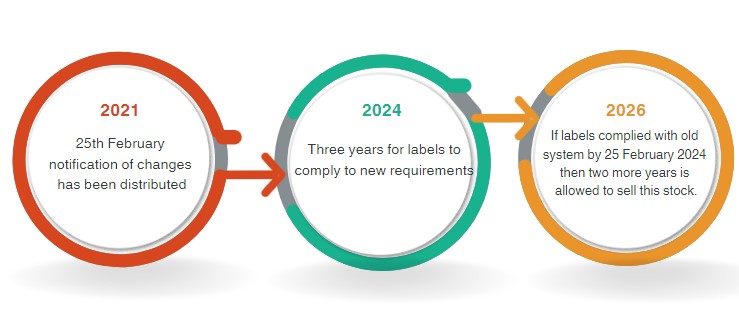In February 2021, Food Standards Australia and New Zealand (FSANZ) announced new requirements for allergen labelling on packaged foods, to help make food allergen declarations clear and consistent for consumers and enable them to make safe food choices.
Prior to this, FSANZ required the 11 known foods and ingredients that can cause severe allergic reactions to be declared on labels when they are present in food. However, there was no requirement on how these declarations were to be made, leading to confusion and uncertainty in consumers which may have potential life-threatening consequences.
What has changed?
Under the new requirements in the Australia New Zealand Food Standards Code (the Code), businesses must state allergens using mandatory specified terms (summarised below in Appendix 1) in bold font, with additional requirements to display them in the statement of ingredients, as well as in a separate allergen summary statement.
The Code amendments require businesses to separate the declaration of molluscs, individual tree nuts (such as Brazil nuts, cashews, and pecans among others) and wheat, barley, rye or oats and gluten if present.
Furthermore, allergen declarations must be made in the statement of ingredients (ingredients list), and must be:
- printed in bold font that provides a distinct contrast with any other text.
- printed in a size of type no less than that used for other text.
- provided as a separate word for each ingredient that is, or contains, an allergen.

Example above provided by FSANZ – Derek Castles
In addition, an allergen summary statement must be provided. This is the list of allergens that are present in the product. This allergen summary statement must be:
- printed in a bold font that provides a distinct contrast with any other text in the statement of ingredients that is not a required name.
- printed in the same type face and size of type as the declarations in the statement of ingredients.
- commence with the word ‘Contains’ and only include the allergens required to be declared.
Allergen Summary Statement example below.

These changes have now come into effect.
This variation to the Code came into effect in February 2021, a three-year transition period followed and we now enter a two-year stock-in-trade period to implement PEAL. This means allergen labelling on any food produced from 25 February 2024 is required to meet the new labelling requirements. Any food packaged and labelled before 25 February 2024 (stock-in-trade) that does not declare allergens in the new format can still be sold for another two years (until 25 February 2026).

What does this mean for your business?
All accredited businesses with Safe Food must be aware of their labelling requirements under the Food Standards Code. Several sections in the Code provide information regarding labelling requirements.
Accredited businesses will need to comply with the PEAL changes by 2026. If you are purchasing new labels, make sure these labels are compliant.
Accredited businesses that are not packaging products will still need to have correct PEAL allergen information readily available for consumers. For example, butchers that sell food containing allergens (e.g. eggs, wheat, gluten) within a display cabinet.
NB: Precautionary Allergen Statements (PAL) are voluntary statements and the Food Standards Code does not regulate them. For more information about PAL please refer to the Allergen Bureau industry guidance.
Further resources
For information on food allergen labelling:
Allergen labelling (foodstandards.gov.au)
Food allergies (foodstandards.gov.au)
Product exemptions from allergen labelling (foodstandards.gov.au)
Australia New Zealand Food Standards Code – Standard 1.2.3 – Information requirements – warning statements, advisory statements and declarations (legislation.gov.au) (section 1.2.3-4 specifically)
Allergen management info:
Allergen Bureau Food Allergy Management | Allergen Bureau
Allergen Risk Review – free interactive tool to conduct an allergen risk review at each stage of the food supply chain.
Food Industry Guide to Allergen Management
Appendix 1
Table 1: Required names for making mandatory declarations
| Allergen declaration | For declarations in a Statement of ingredients | For all other declarations | |
| Added sulphites in concentrations of 10 mg/kg or more | sulphites | sulphites | |
| Wheat and its hybrids | wheat | wheat,
gluten (when gluten is present) |
|
| These cereals and their hybrids (when gluten is present) | Barley | barley | gluten |
| Oats | oats | ||
| Rye | rye | ||
| Milk | milk | milk | |
| Egg | egg | egg | |
| Fish | fish | fish | |
| Crustacea | crustacean | crustacean | |
| Mollusc | mollusc | mollusc | |
| Sesame seed | sesame | sesame | |
| Lupin | lupin | lupin | |
| Soybean | soy, soya or soybean | soy | |
| Peanut | peanut | peanut | |
| Almond | almond | almond | |
| Brazil nut | Brazil nut | Brazil nut | |
| Cashew | cashew | cashew | |
| Hazelnut | hazelnut | hazelnut | |
| Macadamia | macadamia | macadamia | |
| Pecan | pecan | pecan | |
| Pine nut | pine nut | pine nut | |
| Pistachio | pistachio | pistachio | |
| Walnut | walnut | walnut | |
